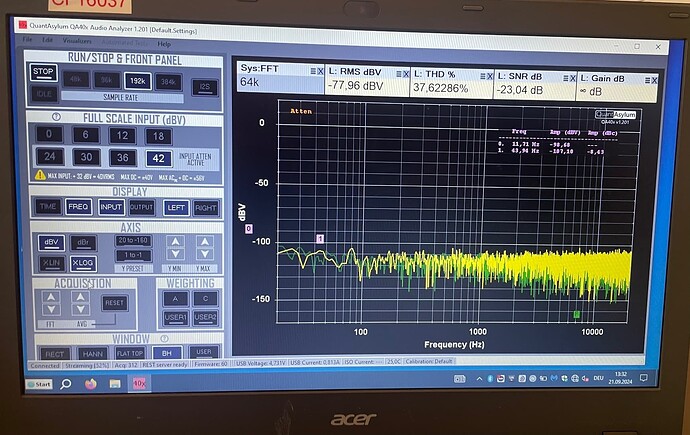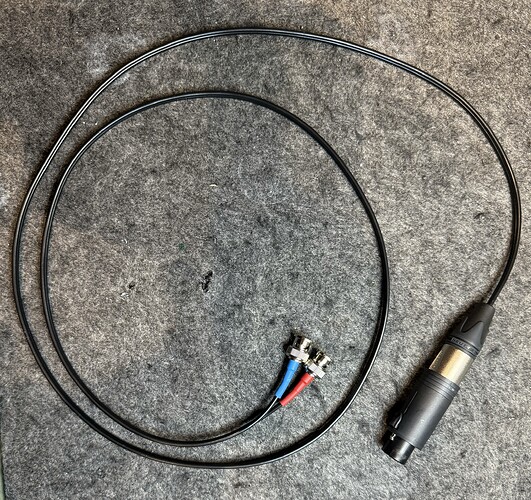Hups, this post was from my other account, it was me who bought the QA403.
Hi,
today I received my QA403 and I made a quick’n dirty measurement, right channel bridged with a cheap BNC - BNC cable, left channel connected to a primary open Micsig DP10013 V2 differential probe at + (- not shorted):
-117dB right and -78dB left (whith open - input) is more than enough for my valve bass amps… Very good stuff!
Hi @cfortner, make sure you short the unused inputs as it will help the noise. Are you making these amps? How many watts?
Shure, but I‘m waiting for the bnc finishing resistors.
I built a Hiwatt DR405 clone with six 6550 (300W) and a valve amp with six KT120 (PI Hiwatt-like, preamp Fender) with 500W (45V RMS at 4 ohm).
I bought the Quantasylum to measure these amps and understand what happens with distortion, harmonics and S/N.
The big one:
My lastname is Fortner, nobody needs these amps, I called them ForWatt 300 and ForWatt 500.
Quite heavy both, but I like valve amp technic.
PI ECC81, driver 12BH7 to drive the six bottles with 120V rms. Special BIAS circuit with low Rg of 50k for stability of BIAS.
These are elder fotos, meanwhile I installed a bigger 500W output transformer.
Anode voltage 830V, 1000VA power transformator.
@cfortner, very, very nice! Did you do all the sheet metal work, faceplates, and upholstery? What is the starting point with the clone you bought? Does it come in the metal case? Or do you start from schematic? PCB or point to point? I must say, this is very impressive.
Now that you can look at the spectrum and amp dynamics, do you have a hunch what has made the amps so enduring?
I’ve shifted the opposite direction, moving to an IR cab modeler effects pedal with full-range bi-amped cabinet normally used for PA.
H Matt,
thanks!
I bought a YAH 100-kit from Tube Town in Germany, thats a Hiwatt 100 clone, it came with chassis and faceplates and was the base of my amp.
The ForWatt 300 is an exact copy of the Hiwatt DR405 with six 6550 with different transformers, built up from scratch with turret boards. Schematic and layout are from hiwatt.org (Mark Huss).
The ForWatt 500 bases on the same chassis and faceplates, but different valves, transformers and BIAS-circuit etc.
KT120 are powerful valves, but very sensible. They need a low resistance BIAS-circuit with a Rg max of 51k.
I developed a circuit with six separate failsafe BIAS pots and Rg max 50k. Thats necessary because the BIAS of the KT120 is very instable with Rg greater than 100k to 150k.
Because I need more than 60V RMS on the grids of the KT120, I constructed a powerful driver with a 12BH7 and 25W cathode resistors.

Lot of work, but it works!
Testing the 12BH7 driver on my breadboard
The result are 60V rms into a load of 12k (3 KT120 in parallel per side).
Halftime
Anode voltage with six bottles biased to 50mA
Preamp installed
Standby Switch for
- two wires AC to the rectifiers
- Switching the powerled from red to green
- Disabling ground from BIAS circuit when off (immediatley full BIAS voltage on the grids = KT120 off)
Connected
No Hiwatt qualitiy, but it works
Two 25W cathode resistors of the driver (12BH7)
500W at 4 ohm (ca. 3-4% THD)
Corresponding BIAS voltages at full power (I changed valve 2 with 151mA)
Preamp circuit fender style
PI, driver and my special BIAS circuit
Power section
Power supply with interrupt switch of BIAS ground and powerled switch red / green. 12,6V is set on +70V because the voltage at the 12BH7 would exceed otherwise their limits.
In the moment I struggle with the headshell and some minor problems .
The amp sounds a little like a bassman on steroid, but I didn‘t test it a lot, little time…
First soundcheck on a FMC 215 4 ohm with two faital 15PR400 speaker
Rear side
But now back to topic:
Today I tested the QA403 carefully with my 4 ohm load and a RedRock Modus 4.5.
First I put end resitors 50 Ohm on each input
and got this:
Not bad, but not VERY good.
Touching the metal of the BNC input gives more hum (50 Hz here in Germany)
Then I connected the output 1 + to the amp
and got more hum!
Got I this hum because I connected the ground of the QA403 with ground of the DUT? The QA403 itself doesn’t have a ground connection, because it is connected only to the laptop.
Have I to use symmetrical cables to prevent this?
I bought some cables from an ebay link here shown, two BNC to 6,3 mm mono. I will change the 6,3 mm connector to a xlr without ground connection, I hope this will fix this hum issue.
Edit: While measuring this, the amp was off, but connected to 230V.
You should always experiment with grounding and the QA403 in my experience.
Sometimes it is better to earth/ground the QA403, sometimes not, whether it be differential connection or single ended. I just have an alligator clip lead which I sometimes clip between the QA403’s BNC outer shell and a nearby ground point on one of my 'scopes.
It can make a little or a huge difference.
Hi @cfortner
Not bad, but not VERY good.
Looks like you are on 42 dBV full scale input. The RMS noise is -78 dBV, and thus the noise is 42 + 78=120) which is -120 dB below full scale, which is quite good!
With the inputs shorted, if you switch to 0 dBV full scale input, you should see about -117 dBV RMS noise.
The QA403 itself doesn’t have a ground connection, because it is connected only to the laptop.
Please take a look at the spectrum with 0 dBV full scale input selected. You first need to make sure you are getting the -117 dBV RMS noise (20 to 20 kHz). This will confirm the shorting blocks are working. It’s not too uncommon to find shorting blocks that have failed or are intermittent. With full scale input at 0 dBV, wiggling/touch the 50 ohm shorting blocks should not yield any changes in RMS and your spectrum should be clean during all this wiggling and poking.
If you open a 50 or 75 ohm shorting block, you will often find a leaded resistor. These will eventually fail as the solder point disconnects from one side.
Can you confirm good spectrum with 0 dBV full scale input?
Next, can you confirm the input ground on the amp (the sleeve part of 1/4") has continuity to earth ground? I know it shows that in your schematic, but it’s good to confirm. You can do this with amp off and unplugged.
BTW, very nice work all around on this amp!
Thanks Matt!
I testet it today after I took new settings and saw this (at 0dB, all 4 inputs with a 50 Ohm shorting resistor):
Thats very good!
Open input left +:
I suggest, it‘s all ok and I have to read the f…… manual.
Where I can switch the distortion measurement to % instead of dB forever?
Hi @Forwatt . Just select the tiles with %. Below how to do it
Thanks a lot! I saw it one time, but didn‘t remember where…
Today the special cables for use with symmetrical devices arrived and I changed two of them from BNC - 6,3 mm to BNC - XLR (male or female):
The original cable
Two of them I fitted with a special Neutrik plug, which is changeable from male to female
So I have two sym cables to the amp, one with a 6,3 plug and one xlr
I choose xlr for good contact and heavy duty.
And one from the load / attenuator to the QA403
Next week I‘ll install the xlr socket and the attenuator to the load resistor, then the sym output is switchable from 0 dB to -20 dB and -40 dB attenuation and sym/unsym with two switches.
Latest infos of my setup:
I built an attenuator and a symm/asymm-switch into my load resistor:
From left to right: 0dB -20dB -40dB
The little switch means symmetrical inputs (down) and asymmetrical inputs (up)
Results:
4 ohms, symm and 0dB:

4 ohms symm and -20dB:

4 ohms symm and -40dB:

4 ohms asymm and -40dB:

An enormous increase of hum due tu the higher impedance and lack of chassis grounding.
With a connection from the alu chassis (isolated from signal path) to QA403 ground (black jack in the middle):
Only ground connected at output R -

-110dB is enough for my purposes:

Thanks a lot für your hints,
Christian









































